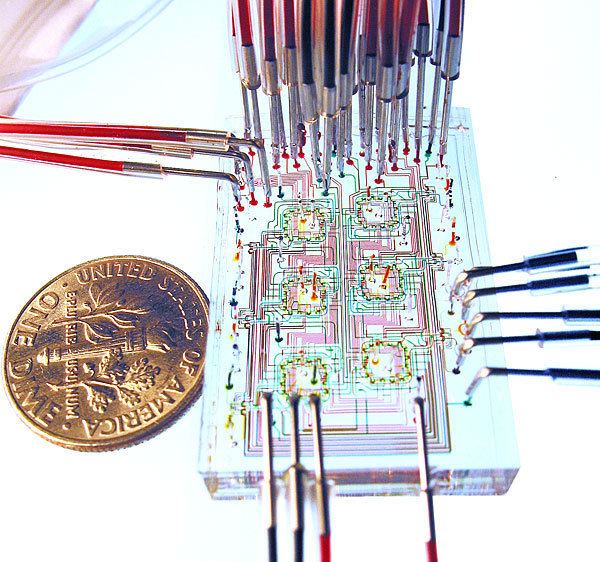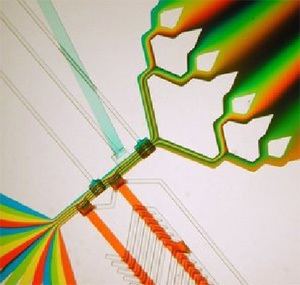 | ||
Microfluidics particle attachment study
Microfluidics deals with the behaviour, precise control and manipulation of fluids that are geometrically constrained to a small, typically sub-millimeter, scale. It is a multidisciplinary field at the intersection of engineering, physics, chemistry, biochemistry, nanotechnology, and biotechnology, with practical applications in the design of systems in which low volumes of fluids are processed to achieve multiplexing, automation, and high-throughput screening. Microfluidics emerged in the beginning of the 1980s and is used in the development of inkjet printheads, DNA chips, lab-on-a-chip technology, micro-propulsion, and micro-thermal technologies.
Contents
- Microfluidics particle attachment study
- Explainer video world of microfluidics european micro cup microfluidics and microbioreactor
- Microscale behaviour of fluids
- Key application areas
- Continuous flow microfluidics
- Droplet based microfluidics
- Digital microfluidics
- DNA chips microarrays
- Molecular biology
- Evolutionary biology
- Cell behavior
- Cellular biophysics
- Optics
- Acoustic droplet ejection ADE
- Fuel cells
- Future Directions
- References
Typically, micro means one of the following features:
Typically fluids are moved, mixed, separated or otherwise processed. Numerous applications employ passive fluid control techniques like capillary forces. In some applications, external actuation means are additionally used for a directed transport of the media. Examples are rotary drives applying centrifugal forces for the fluid transport on the passive chips. Active microfluidics refers to the defined manipulation of the working fluid by active (micro) components such as micropumps or microvalves. Micropumps supply fluids in a continuous manner or are used for dosing. Microvalves determine the flow direction or the mode of movement of pumped liquids. Often processes which are normally carried out in a lab are miniaturised on a single chip in order to enhance efficiency and mobility as well as reducing sample and reagent volumes.

Explainer video world of microfluidics european micro cup microfluidics and microbioreactor
Microscale behaviour of fluids

The behaviour of fluids at the microscale can differ from "macrofluidic" behaviour in that factors such as surface tension, energy dissipation, and fluidic resistance start to dominate the system. Microfluidics studies how these behaviours change, and how they can be worked around, or exploited for new uses.

At small scales (channel size of around 100 nanometers to 500 micrometers) some interesting and sometimes unintuitive properties appear. In particular, the Reynolds number (which compares the effect of the momentum of a fluid to the effect of viscosity) can become very low. A key consequence is co-flowing fluids do not necessarily mix in the traditional sense, as flow becomes laminar rather than turbulent; molecular transport between them must often be through diffusion.

High specificity of chemical and physical properties (concentration, pH, temperature, shear force, etc.) can also be ensured resulting in more uniform reaction conditions and higher grade products in single and multi-step reactions.
Key application areas

Microfluidic structures include micropneumatic systems, i.e. microsystems for the handling of off-chip fluids (liquid pumps, gas valves, etc.), and microfluidic structures for the on-chip handling of nanoliter (nl) and picoliter (pl) volumes. To date, the most successful commercial application of microfluidics is the inkjet printhead. Additionally, advances in microfluidic manufacturing allow the devices to be produced in low-cost plastics and part quality may be verified automatically.
Advances in microfluidics technology are revolutionizing molecular biology procedures for enzymatic analysis (e.g., glucose and lactate assays), DNA analysis (e.g., polymerase chain reaction and high-throughput sequencing), and proteomics. The basic idea of microfluidic biochips is to integrate assay operations such as detection, as well as sample pre-treatment and sample preparation on one chip.
An emerging application area for biochips is clinical pathology, especially the immediate point-of-care diagnosis of diseases. In addition, microfluidics-based devices, capable of continuous sampling and real-time testing of air/water samples for biochemical toxins and other dangerous pathogens, can serve as an always-on "bio-smoke alarm" for early warning.
Microfluidic technology has led to the creation of powerful tools for biologists to control the complete cellular environment, leading to new questions and discoveries. Many diverse advantages of this technology for microbiology are listed below:
Some of these areas are further elaborated in the sections below.
Continuous-flow microfluidics
These technologies are based on the manipulation of continuous liquid flow through microfabricated channels. Actuation of liquid flow is implemented either by external pressure sources, external mechanical pumps, integrated mechanical micropumps, or by combinations of capillary forces and electrokinetic mechanisms. Continuous-flow microfluidic operation is the mainstream approach because it is easy to implement and less sensitive to protein fouling problems. Continuous-flow devices are adequate for many well-defined and simple biochemical applications, and for certain tasks such as chemical separation, but they are less suitable for tasks requiring a high degree of flexibility or fluid manipulations. These closed-channel systems are inherently difficult to integrate and scale because the parameters that govern flow field vary along the flow path making the fluid flow at any one location dependent on the properties of the entire system. Permanently etched microstructures also lead to limited reconfigurability and poor fault tolerance capability.
Process monitoring capabilities in continuous-flow systems can be achieved with highly sensitive microfluidic flow sensors based on MEMS technology which offers resolutions down to the nanoliter range.
Droplet-based microfluidics
Droplet-based microfluidics as a subcategory of microfluidics in contrast with continuous microfluidics has the distinction of manipulating discrete volumes of fluids in immiscible phases with low Reynolds number and laminar flow regimes. Interest in droplet-based microfluidics systems has been growing substantially in past decades. Microdroplets offer the feasibility of handling miniature volumes (μl to fl) of fluids conveniently, provide better mixing, encapsulation, sorting, sensing and are suitable for high throughput experiments. Exploiting the benefits of droplet-based microfluidics efficiently requires a deep understanding droplet generation to perform various logical operations such as droplet motion, droplet sorting, droplet merging, and droplet breakup.
Two immiscible phases used for the droplet generation are termed as the continuous phase (medium in which droplets are generated) and dispersed phase (the droplet phase). The size of the generated droplets is mainly controlled by the flow rates of the continuous phase and dispersed phase, interfacial tension between two phases and the geometry used for the droplet generation. Generally, three types of microfluidic geometries are utilised for the droplet generation : (i) T-Junction, (ii) Flow Focusing, and (iii) Co-Flowing. T-junction geometry follows a linear scaling law for the droplet generation and hence, simple to use.
Micromagnetofluidic method, which is the control of magnetic fluids by an applied magnetic field on a microfluidic platform, offers wireless and programmable control of the magnetic droplets. Hence, the magnetic force can also be used to perform various logical operations, in addition to the hydrodynamic force and the surface tension force. The magnetic field strength, type of the magnetic field (gradient, uniform or rotating), magnetic susceptibility, interfacial tension, flow rates, and flow rate ratios determine the control of the microdroplets on a micromagnetofluidic platform.
One of the key advantages of droplet-based microfluidics is the ability to use droplets as incubators for single cells.
Devices capable of generating thousands of droplets per second opens new ways characterise cell population, not only based on a specific marker measured at a specific time point but also based on cells kinetic behaviour such as protein secretion, enzyme activity or proliferation. Recently, a method was found to generate a stationary array of microscopic droplets for single-cell incubation that does not require the use of a surfactant .
Droplet based devices have also been used to investigate the conditions necessary for protein crystallization.
Digital microfluidics
Alternatives to the above closed-channel continuous-flow systems include novel open structures, where discrete, independently controllable droplets are manipulated on a substrate using electrowetting. Following the analogy of digital microelectronics, this approach is referred to as digital microfluidics. Le Pesant et al. pioneered the use of electrocapillary forces to move droplets on a digital track. The "fluid transistor" pioneered by Cytonix also played a role. The technology was subsequently commercialised by Duke University. By using discrete unit-volume droplets, a microfluidic function can be reduced to a set of repeated basic operations, i.e., moving one unit of fluid over one unit of distance. This "digitisation" method facilitates the use of a hierarchical and cell-based approach for microfluidic biochip design. Therefore, digital microfluidics offers a flexible and scalable system architecture as well as high fault-tolerance capability. Moreover, because each droplet can be controlled independently, these systems also have dynamic reconfigurability, whereby groups of unit cells in a microfluidic array can be reconfigured to change their functionality during the concurrent execution of a set of bioassays. Although droplets are manipulated in confined microfluidic channels, since the control on droplets is not independent, it should not be confused as "digital microfluidics". One common actuation method for digital microfluidics is electrowetting-on-dielectric (EWOD). Many lab-on-a-chip applications have been demonstrated within the digital microfluidics paradigm using electrowetting. However, recently other techniques for droplet manipulation have also been demonstrated using surface acoustic waves, optoelectrowetting, mechanical actuation, etc.
DNA chips (microarrays)
Early biochips were based on the idea of a DNA microarray, e.g., the GeneChip DNAarray from Affymetrix, which is a piece of glass, plastic or silicon substrate, on which pieces of DNA (probes) are affixed in a microscopic array. Similar to a DNA microarray, a protein array is a miniature array where a multitude of different capture agents, most frequently monoclonal antibodies, are deposited on a chip surface; they are used to determine the presence and/or amount of proteins in biological samples, e.g., blood. A drawback of DNA and protein arrays is that they are neither reconfigurable nor scalable after manufacture. Digital microfluidics has been described as a means for carrying out Digital PCR.
Molecular biology
In addition to microarrays, biochips have been designed for two-dimensional electrophoresis, transcriptome analysis, and PCR amplification. Other applications include various electrophoresis and liquid chromatography applications for proteins and DNA, cell separation, in particular, blood cell separation, protein analysis, cell manipulation and analysis including cell viability analysis and microorganism capturing.
Evolutionary biology
By combining microfluidics with landscape ecology and nanofluidics, a nano/micro fabricated fluidic landscape can be constructed by building local patches of bacterial habitat and connecting them by dispersal corridors. The resulting landscapes can be used as physical implementations of an adaptive landscape, by generating a spatial mosaic of patches of opportunity distributed in space and time. The patchy nature of these fluidic landscapes allows for the study of adapting bacterial cells in a metapopulation system. The evolutionary ecology of these bacterial systems in these synthetic ecosystems allows for using biophysics to address questions in evolutionary biology.
Cell behavior
The ability to create precise and carefully controlled chemoattractant gradients makes microfluidics the ideal tool to study motility, chemotaxis and the ability to evolve / develop resistance to antibiotics in small populations of microorganisms and in a short period of time. These microorganisms including bacteria and the broad range of organisms that form the marine microbial loop, responsible for regulating much of the oceans' biogeochemistry.
Microfluidics has also greatly aided the study of durotaxis by facilitating the creation of durotactic (stiffness) gradients.
Cellular biophysics
By rectifying the motion of individual swimming bacteria, microfluidic structures can be used to extract mechanical motion from a population of motile bacterial cells. This way, bacteria-powered rotors can be built.
Optics
The merger of microfluidics and optics is typical known as optofluidics. Examples of optofluidic devices are tunable microlens arrays and optofluidic microscopes.
Microfluidic flow enables fast sample throughput, automated imaging of large sample populations, as well as 3D capabilities. or superresolution.
Acoustic droplet ejection (ADE)
Acoustic droplet ejection uses a pulse of ultrasound to move low volumes of fluids (typically nanoliters or picoliters) without any physical contact. This technology focuses acoustic energy into a fluid sample in order to eject droplets as small as a millionth of a millionth of a litre (picoliter = 10−12 litre). ADE technology is a very gentle process, and it can be used to transfer proteins, high molecular weight DNA and live cells without damage or loss of viability. This feature makes the technology suitable for a wide variety of applications including proteomics and cell-based assays.
Fuel cells
Microfluidic fuel cells can use laminar flow to separate the fuel and its oxidant to control the interaction of the two fluids without a physical barrier as would be required in conventional fuel cells.
